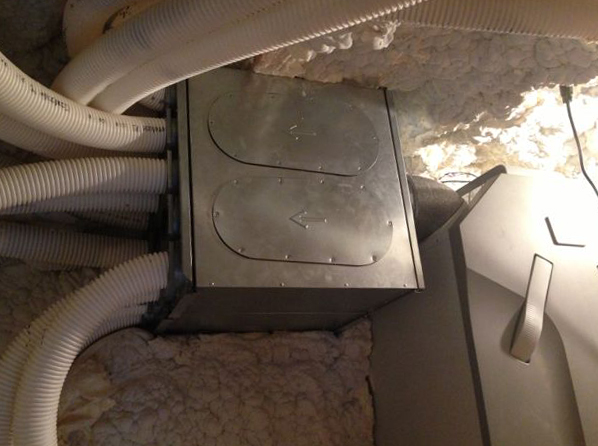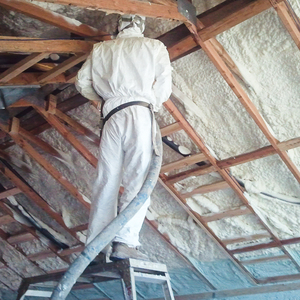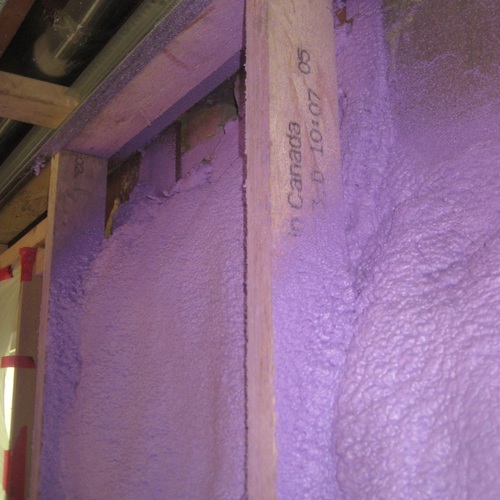
Image Credit: Energy Vanguard
Most installations of spray foam insulation, when properly installed, act as an air barrier. When you use it instead of the fluffy stuff (fiberglass, cellulose, cotton), a house will be more airtight. That’s good.
When a house is airtight, the nasties in the indoor air tend to stick around. Volatile organic compounds (VOCs), water vapor, odors, radon, and other stuff you don’t want to immerse yourself in make the home’s indoor air quality worse.
How do you solve this problem? Mechanical ventilation. Well, source reduction and separation would come first, but airtight homes need mechanical ventilation.
The role and responsibilities of spray foam contractors
If I were a spray polyurethane foam (SPF) insulation contractor, I’d do like they all do and make sure that every potential customer I talked to knew about SPF’s air sealing qualities. (I would not, however, try to sell people on fantasy R-values of 20 or 40 per inch, which I have known some SPF contractors to do.)
Then I’d do what not nearly enough spray foam contractors do: I’d tell all my customers they need to install a mechanical ventilation system in every new home with spray foam. In fact, I’d include mechanical ventilation as one of the things I sell. (Maybe that’s just because I’d rather be an HVAC contractor, though.)
If a client didn’t want me to do the ventilation, I’d have them sign a liability waiver acknowledging that they have been informed about the importance of mechanical ventilation in airtight homes. Then I’d have that piece of paper so I could pull it out if the homeowner ever came after me for poor indoor air quality.
I’m not the only one saying that ventilation needs to be part of new homes with spray foam insulation. Recently, Mac Sheldon of Demilec emailed me about this issue and wrote, “I’m telling… preaching… admonishing… SPF contractors to never pull the trigger on a spray foam job until there’s a ventilation plan in place.”
I believe that spray foam insulation can be an effective product to use in building enclosures. I also know that spray foam can be done poorly. No matter which way it’s done, however, mechanical ventilation is not optional in airtight homes. I wonder how many spray foam contractors will find that out the hard way.
Allison Bailes of Decatur, Georgia, is a speaker, writer, energy consultant, RESNET-certified trainer, and the author of the Energy Vanguard Blog. Check out his in-depth course, Mastering Building Science at Heatspring Learning Institute, and follow him on Twitter at @EnergyVanguard.
Weekly Newsletter
Get building science and energy efficiency advice, plus special offers, in your inbox.















7 Comments
A very important point, indeed.
I'm coming to believe, after doing some IAQ testing, that EVERY house should have fresh air ventilation, but especially those that are substantially tightened. And spray foam tightens better than everything else. In the plans Energy Smart builds, at least one involves ventilation, it is always a recommendation. Thanks for pointing it out.
Cheap.and easy Venting
A PTHP at 26" solves about every problem. I learned this the hard way after loosing 7k on a bad mini split install last year.
-Most under a $1000
-Easy to install
- -Basic Carpentry skills
- -No HVAC professional needed
-Easy replacement
- -Slips in and out with sleave
-Heat pumps are effecient on these units
-New models are quieter
-Any air leakage at heat and cooling source is fresh air at the correct opening
That last one is important. Its probably the main reason its not recommended. If the house is tight the best venting is through the HVAC system. The reason its not recommended becomes the reason you do want install it.
I'm soured on the mini split use because of experience. The PTHP has become an asset that solved so many of the issues I ran into. I believe this is a good solution for many others as well.
PS
EPA wood stoves in conjunction with the PTHP is a winning scenerio.
Ventilation
I wonder when Mac Sheldon states... "I'm telling... preaching... admonishing... SPF contractors to never pull the trigger on a spray foam job until there's a ventilation plan in place." if he's really telling you it's about the ventilation during the spray foam process. You know, the removable portable fan type... blow the vapors out the window type. This industry always amazes me with how they spin their words if you do not nail them down with a specific question on a specific topic.
But...
...depending on where you live and outdoor conditions, sometimes the outdoor air may be worst than your indoor air. Just saying...it happens.
Decked out in foam
I am in the middle of my build and will be doing flash/batt all exterior walls and closed cell foam on the roof deck. I am also encapsulating my full, stand-up crawl space. I live in Zone 4-A. I have had difficulty convincing my builder and their HVAC guy that I need an ERV. Hopefully this article will help them see my point.
Humidity
I use a ducted dehumidifier (ultra Aire) in my studio. The dehumidifier is connected to an external air inlet as well as interior vent -- both then go through a filter before entering the dehumidifier. The unit then has a single exhaust vent. My studio is 1700 sf -- one big space. Living a bit north of Philadelphia we experience humidity many days of the year. The unit is controlled by both inside humidity and a timer .. during the more humid months or when I am in the building often the humidity inside is high enough to cycle the unit -- otherwise it runs on a timer .. I want it to run every day. Building is built with SIP's
I'm rebuilding my house (insulation will be foam) and plan on using a larger unit with a more sophisticated control. The question no one can answer is -- How much incoming air?
My friend had an HRV/ERV installed in his house -- basically a second expensive duct system. They installed inlets in the bathrooms and kitchen as well as the lower level/ laundry room -- the fresh returns are in other areas of the living space. The theory was this would take care of the bathrooms and remove smells from the house. It does not have enough flow to clear the bathrooms .. and the filters are always a mess and expensive to replace ... and he still needs a dehumidifier.
We have Radon in our area BTW. I'm going to install dedicated fantech exhaust fans in the bathrooms to quickly clear the air -- same for the kitchen. In my area using a ducted dehumidifier makes more sense IMO. I'm getting conflicting reports on how sophisticated the return ductwork needs to be. Some are saying to keep it simple and others are telling me that it needs to be connected to the HVAC system.
Also - trying to get information on how best to create "make up air" for a large stove hood is also a problem.
An ideal system would be running very slowly all the time -- to proved the proper clean air and to pressurize the house.
We have a foam insulated home in Texas. I am disturbed by the attic fumes coming Into the living space. What are the proper steps to resolve this?
Log in or create an account to post a comment.
Sign up Log in